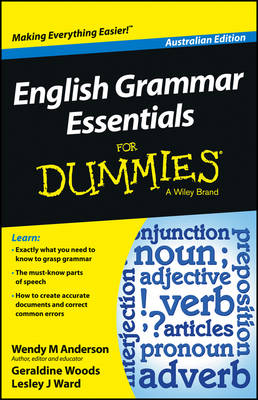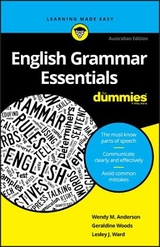
English Grammar Essentials For Dummies – Australia
John Wiley & Sons Australia Ltd (Verlag)
978-1-118-49331-1 (ISBN)
- Titel erscheint in neuer Auflage
- Artikel merken
The fun and easy way to learn essential grammar rules, common usage errors, and other key concepts in the English language
Understanding the rules of English is key to being an effective communicator—at work, at school, or anywhere else. If you struggle with the rules—and who hasn't?—English Grammar Essentials For Dummies, Australian Edition is the book for you. Covering just the basics you need, the book boils the rules of grammar down to the core concepts that will make you a better communicator in any and every aspect of your life.
Ideal for students, job hunters, adult learners, those who speak English as a second language, and anyone who wants to make a good impression
Covers the vital essentials needed for better written communication
Serves as an excellent refresher course for professionals whose primary mode of communication is increasingly electronic and written
Clear and understandable writing can be the key to success in almost any professional field. With English Grammar Essentials For Dummies, Australian Edition, you'll master the basics with ease!
Wendy M Anderson is an author, editor and educator. She has taught effective communication in classroom and business environments for over 20 years. Geraldine Woods has taught grammar for over 25 years. Lesley J Ward is a founding member of the UK Society for Editors and Proofreaders.
Introduction 1
About This Book 1
Foolish Assumptions 2
Icons Used in This Book 2
Where to Go from Here 3
Chapter 1: Grappling with Grammar 5
Grasping Grammar: Good and Proper 6
Using Aussie English 7
Having a Quick Squiz at Aussie Words 8
Choosing Levels of English 10
Impressing with formal English 10
Chatting in informal English 11
Labelling Words 12
Nouns 12
Pronouns 12
Verbs 13
Adjectives 13
Adverbs 14
Verbals 14
Determiners 15
Prepositions 15
Conjunctions 16
Chapter 2: Controlling Verbs 17
Verifying Verbs 17
Happening with action verbs 18
Being with linking verbs 18
Helping out in verb groups 20
Finding the whole verb 21
Simplifying Subjects 22
Locating the subject 22
Baring the complete subject 22
Uncovering a hidden subject 23
Commanding an implied subject 23
Making Subjects and Verbs Agree 24
Separating singles from plurals 24
Adjusting verbs to match subjects 25
Matching two subjects 27
Looking like Verbs: Verbals 28
Participating with participles 28
Naming gerunds 28
Defining infinitives 30
Chapter 3: Completing Sentences 31
Having Subject–Verb Pairs 31
Expressing Complete Thoughts 33
Creating Completeness with Clauses 33
Understanding clauses 34
Telling main from dependent clauses 35
Considering Fragments 36
Fragmented subject–verb pair 37
Fragmented ideas 37
Contemplating Complements 39
Receiving direct objects 40
Baring complete objects 40
Identifying the direct object or complement 41
Recognising indirect objects 42
Completing Linking Verbs 43
Complementing the Object 44
Chapter 4: Peaking with Pronouns 45
Matching Pronouns with Nouns 46
Avoiding Vague Pronoun Use 46
Choosing Singular and Plural Pronouns 47
Pairing Pronouns with Collective Nouns 48
Selecting Pronouns as Subjects 49
Matching more than one subject 50
Selecting pronouns as objects 51
Knowing Who or Whom 51
Comparing with Pronouns 52
Owning Possessive Pronouns 52
Reflecting on Reflexive Pronouns 53
Chapter 5: Modifying with Descriptions 55
Adding Meaning with Adjectives 55
Describing with Adjectives 56
Locating adjectives 57
Adding adjectives to nouns 57
Adding adjectives to pronouns 59
Using adjectives with linking verbs 59
Describing with Adverbs 60
Finding adverbs 60
Using adverbs to describe other describing words 61
Using adverbs to modify a complete statement 62
Misplacing Descriptions 63
Dangling a Description in Space 64
Squinting Descriptions 66
Chapter 6: Punctuating for Meaning 67
Conquering Commas 67
Using commas in lists 68
Addressing people directly 70
Noting introductory and concluding words 71
Adding extra detail with pairs of commas 72
Connecting commas with conjunctions 73
Airing All about Apostrophes 74
Using apostrophes in contractions 74
Owning apostrophes of possession 75
Simplifying Semicolons 79
Hinging complete thoughts 79
Joining with conjuncts 79
Separating in lists 80
Clarifying Colons 80
Setting up long lists 81
Setting up extracts 81
Expanding on an idea 81
Dealing with Dashes 82
Using the humble hyphen with words 82
Using the humble hyphen with numbers 83
Embracing Em and En Dashes 84
Chapter 7: Choosing Capital Letters and Numerals 87
Covering the Basics of Capitalisation 88
Speaking officially 88
Addressing family 89
Capitalising directions 89
Understanding geographical capital letters 90
Talking about history 91
Referring to times and times of year 91
Looking at titles 92
Deciding When to Use Numerals 93
Chapter 8: Avoiding Tricky Situations 95
Eliminating Sexist Pronouns 95
Choosing Between Adjectives and Adverbs 97
Choosing between good and well 97
Choosing between real and really 98
Being Clear with Even, Almost and Only 99
Understanding the Connection Between Which,That and the Comma 101
Creating Clear Comparisons 101
Controlling regular comparisons 102
Mastering irregular comparisons 103
Eradicating illogical comparisons 104
Storytelling in Past or Present Tense 105
Choosing past or present tense 105
Mixing tenses 106
Choosing between done and did 107
Using lie, lay, laid, lain 108
Matching Up Two-Part Conjunctions 109
Ending the Problem with I or Me 110
Editing Out Empty Subjects: Its, Here and There 112
Ending a Sentence with a Preposition 113
Chapter 9: Reporting Speech and Quoting Others 115
Quoting Someone Else 115
Punctuating Block Quotations 116
Joining the Dots with Ellipses 118
Putting Brackets within Quotations 119
Recording Titles 121
Writing Conversation: Quotation Marks 122
Indicating indirect speech 122
Dealing with direct speech 123
Showing a change of speaker 129
Writing someone’s thought 131
Creating Scare Quotes: Aerial Quotation Marks 132
Chapter 10: Writing with Style 133
Building Better Sentences 133
Pairing equal ideas: Coordination 133
Demoting lesser ideas: Subordination 135
Creating logic with coordination and subordination 137
Varying sentence patterns 139
Finding the Right Voice: Active and Passive 140
Creating Writing That Flows: Cohesion 143
Putting ideas in order: Sequencing 144
Connecting ideas with transition words 145
Being Absolutely Clear: Plain English 146
Avoiding word-wasting 147
Selecting the best words 149
Staying positive 149
Chapter 11: Creating More Accurate Documents 151
Summarising with Bullet Point Lists 151
Handling Addresses and Dates 153
Adding addresses 154
Dealing with the date 154
Filling in the Rules for Abbreviations 155
Stretching out acronyms 156
Clearing up initialisms 157
Ensuring Effective Emails 157
Establishing who, why and what 158
Averting potential disaster 159
Focussing on Visual Presentations 160
Presenting Perfect Bibliographies 162
Understanding author–date system versus documentary–note system 162
Defining a reference list 163
Chapter 12: Ten Solutions to the Most Common Grammar Errors 167
Adding Apostrophes (Or Not) 167
Reaching Agreement 168
Staying in the Right Tense 169
Splicing Sentences with a Comma 169
Running Sentences On 170
Fragmenting Sentences 170
Misplacing Modifiers 170
Knowing When to Use Subject and Object Pronouns 171
Selecting Prepositions 171
Confusing ‘Of’ with ‘Have’ 172
Index 173
| Erscheint lt. Verlag | 15.10.2013 |
|---|---|
| Verlagsort | Milton, QLD |
| Sprache | englisch |
| Maße | 139 x 216 mm |
| Gewicht | 256 g |
| Themenwelt | Schulbuch / Wörterbuch ► Wörterbuch / Fremdsprachen |
| Geisteswissenschaften ► Sprach- / Literaturwissenschaft ► Sprachwissenschaft | |
| ISBN-10 | 1-118-49331-1 / 1118493311 |
| ISBN-13 | 978-1-118-49331-1 / 9781118493311 |
| Zustand | Neuware |
| Informationen gemäß Produktsicherheitsverordnung (GPSR) | |
| Haben Sie eine Frage zum Produkt? |
aus dem Bereich



